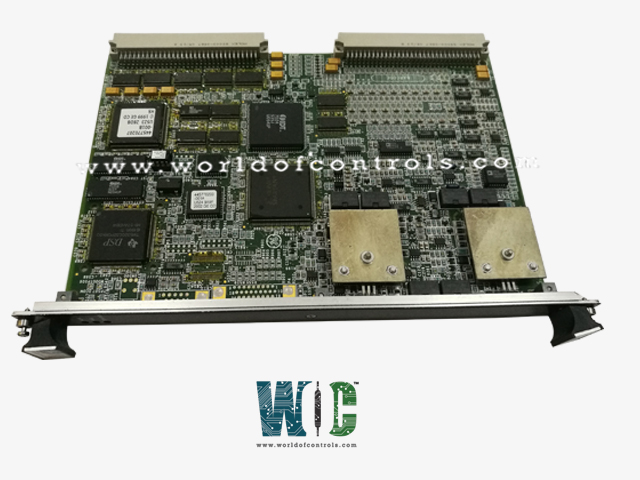SPECIFICATIONS
Part No.: IS200VAICH1DBC
Manufacturer: General Electric
Country of Manufacture: United States of America (USA)
Temperature: 0 to 60 �C
Size: 26.04 cm high x 1.99 cm wide x 18.73 cm deep
Power consumption: Less than 31 MW
Number of channels: 24
Product Type: Analog I/O Board
Availability: In Stock
Series: Mark VI
Functional Description
IS200VAICH1DBC is an analog I/O board developed by GE. It is a part of Mark VI control system. The Analog Input Board stands as a pivotal component within a sophisticated control system, adeptly handling a multitude of analog inputs and outputs. It boasts the capability to accept 20 analog inputs, providing a versatile solution for systems requiring extensive analog monitoring. In addition to its input functions, the VAIC board is equipped to control four analog outputs, further enhancing its role in managing diverse signals within the system. To facilitate connectivity, the Analog Input terminal board, accommodates ten inputs and two outputs. The interfacing cables establish a robust connection between the terminal board and the VME rack, housing the processor board.
Data Conversion and Transmission
- Digital Conversion: The processor board undertakes the crucial task of converting the analog inputs into digital values. This digital data is then transmitted over the VME backplane to the board, forming an integral part of the communication pathway within the control system.
- Controller Interaction: The converted digital values proceed to the controller, enabling the system to interpret and respond to the analog signals received by the VAIC. This seamless interaction ensures that the controller can make informed decisions based on the monitored inputs.
Output Handling
- Digital to Analog Conversion: When it comes to output signals, the VAIC operates in reverse, converting digital values received from the controller into analog currents. These currents are then directed through the terminal board, making their way into the customer circuit for further utilization.
- Simplex and TMR Support: The flexibility extends to its support for both simplex and triple modular redundant (TMR) configurations. In TMR applications, input signals are distributed to three board racks, each equipped with a VAIC. Output signals are intelligently managed using a proprietary circuit that leverages all three VAICs to create the desired current. In the event of a hardware failure, the system seamlessly continues operation with the remaining two functional boards. In a simplex configuration, the terminal board provides input signals to a single VAIC, which then singularly handles all current output responsibilities.
- Enhanced Reliability and Fault Tolerance: The TMR architecture of the module ensures enhanced reliability and fault tolerance. In case of a hardware failure, the redundant configuration enables the system to continue functioning accurately, showcasing the board's resilience and commitment to maintaining optimal performance.
Compatibility
- Increased Voltage Output: The VAICH1D and its successors are engineered to accommodate higher load resistances, a significant enhancement compared to previous versions. With a drive voltage capability of up to 18 V at the terminal board screw terminals, the VAIC board opens up possibilities for more robust and versatile applications.
- Extended Load Operation: This increased voltage capacity translates into the ability to operate into loads of up to 800 ohm. The VAICH1D's extended load handling capability, when coupled with 1000 ft of #18 wire, ensures reliable performance with a comfortable margin. This expansion in load resistance is particularly beneficial for applications demanding higher impedance circuits.
- Terminal Board Compatibility: Revised Terminal Board Requirements: To complement the advanced features, a corresponding revision in the terminal board is necessary. This generation of the board mandates the use of TBAIH1C or later versions for seamless compatibility. Additionally, any revision of STAI is deemed suitable for this purpose. These terminal boards are designed to optimize the integration and subsequent releases, ensuring a harmonious and efficient operation of the overall system.
- Tailored for Diverse Applications: The improved load resistance capabilities and voltage output options make the VAICH1D well-suited for a variety of applications where precision, reliability, and adaptability are paramount. The board's design aligns with the evolving needs of modern control systems, providing engineers and system integrators with a versatile tool for their analog input requirements.
- Seamless Migration: For systems currently utilizing earlier versions of the board, the transition to the H1D introduces an avenue for seamless enhancement. The backward compatibility considerations, especially with regard to terminal boards, facilitate a smooth migration path, allowing existing systems to take advantage of the latest features without undergoing major overhauls.
The WOC team is always available to help you with your Mark VI requirements. For more information, please contact WOC.
Frequently Asked Questions
What is IS200VAICH1DBC?
It is an analog I/O board developed by GE under the Mark VI series.
How does the system handle hardware incompatibility issues with the terminal board?
The I/O processor interrogates the ID device on the terminal board, and when a mismatch is detected, signaling a hardware incompatibility, a fault is immediately created. This robust mechanism ensures that the system is alerted to any discrepancies in the configuration, allowing for prompt resolution of compatibility issues.
Why is monitoring D/A outputs and currents crucial in TMR systems?
Monitoring D/A outputs and currents in TMR systems is critical to ensure the reasonability and accuracy of the signals. Any deviations or abnormalities in these parameters can be indicative of potential issues in the redundancy setup, allowing for swift corrective actions to be taken.
What is the significance of monitoring suicide relays and scaling relays in TMR setups?
Suicide relays and scaling relays play integral roles in TMR systems. Monitoring these relays ensures their proper functioning, contributing to the overall reliability and safety of the system. Faults in these relays can be indicative of potential risks that need attention.
